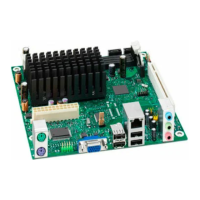Overview of BIOS Features
65
3.6 BIOS Updates
The BIOS can be updated using either of the following utilities, which are available on
the Intel World Wide Web site:
• Intel
®
Express BIOS Update utility, which enables automated updating while in the
Windows environment. Using this utility, the BIOS can be updated from a file on a
hard disk, a USB drive (a flash drive or a USB hard drive), or a CD-ROM, or from
the file location on the Web.
• Intel
®
Flash Memory Update Utility, which requires booting from DOS. Using this
utility, the BIOS can be updated from a file on a hard disk, a USB drive (a flash
drive or a USB hard drive), or a CD-ROM.
Both utilities verify that the updated BIOS matches the target system to prevent
accidentally installing an incompatible BIOS.
NOTE
Review the instructions distributed with the upgrade utility before attempting a BIOS
update.
For information about Refer to
BIOS update utilities http://downloadcenter.intel.com
3.6.1 BIOS Recovery
It is unlikely that anything will interrupt a BIOS update; however, if an interruption
occurs, the BIOS could be damaged. Table 31 lists the drives and media types that
can and cannot be used for BIOS recovery. The BIOS recovery media does not need
to be made bootable.
Table 31. Acceptable Drives/Media Types for BIOS Recovery
Media Type Can be used for BIOS recovery?
CD-ROM drive connected to the SATA interface Yes
USB removable drive (a USB Flash Drive, for example) Yes
USB diskette drive (with a 1.44 MB diskette) No
USB hard disk drive No
For information about Refer to
BIOS update instructions http://support.intel.com/support/motherboards/desktop/
sb/CS-022312.htm

